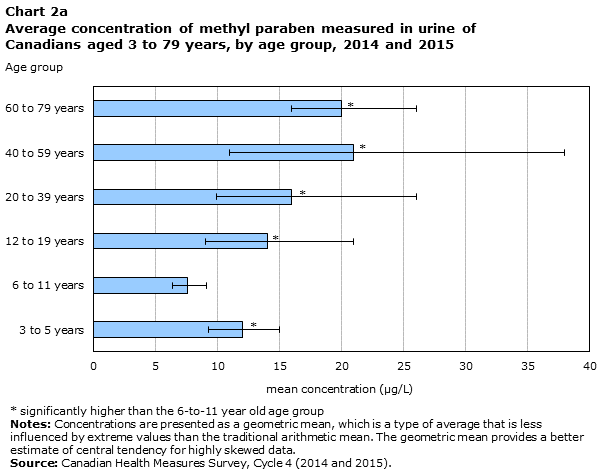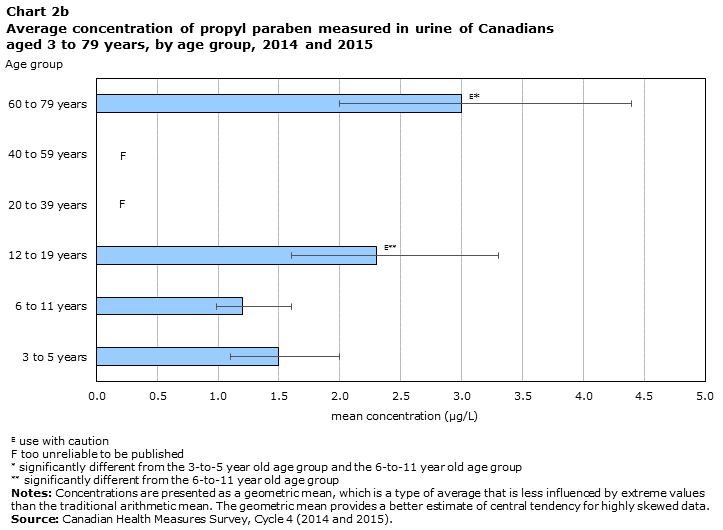Health Fact Sheets
Paraben concentrations in Canadians, 2014 and 2015
Archived Content
Information identified as archived is provided for reference, research or recordkeeping purposes. It is not subject to the Government of Canada Web Standards and has not been altered or updated since it was archived. Please "contact us" to request a format other than those available.
Parabens are a group of chemicals that are often used to prevent the growth of bacteria and mold in cosmetic products, pharmaceuticals, foods, and beverages. Common parabens include methyl paraben, ethyl paraben, propyl paraben, and butyl paraben. They enter the body through the skin or when swallowed or eaten. Following exposure to parabens, they are absorbed, metabolized and then excreted in urine. Detectable levels of parabens are expected to reflect recent paraben exposure since there is no evidence that parabens are stored in the human body in significant quantities.Note 1Note 2Note 3Note 4 Finding detectable levels of parabens in urine is an indicator of exposure to parabens and does not necessarily mean that an adverse health effect will occur. Although associations have been documented between parabens and human health, at this time, no adverse health effects in humans have been causally linked to the use of parabens.Note 1Note 2Note 3Note 4
In 2014 and 2015, the Canadian Health Measures Survey (CHMS) measured the concentrations of parabens (including methyl paraben, ethyl paraben, propyl paraben, and butyl paraben) in the urine of approximately 2500 Canadians aged 3 to 79. Results were reported in micrograms per litre (μg/L).
Majority of Canadians had detectable levels of parabens in their urine
Results from the 2014 and 2015 CHMS indicate that 93% of Canadians aged 3 to 79 had at least one paraben detected in their urine (methyl paraben, ethyl paraben, propyl paraben or butyl paraben). The youngest age group (3- to 5-year-olds) had the highest proportion of the population with detectable levels of any of the four parabens at 96%, while the 40- to 59-year-old age group had the lowest at 91%.
Methyl paraben was the most commonly detected paraben among Canadians—90% had detectable levels. Less than half (42%) of Canadians had detectable levels of ethyl paraben. Three quarters (78%) of Canadians had detectable levels of propyl paraben in their urine. Butyl paraben was the least detected paraben with measureable levels found in 19% of the population.
More females than males had detectable levels of parabens in their urine
A significantly higher proportion of females (96%) had detectable levels of at least one of the four measured parabens compared with males (90%). For example, 94% of females had detectable levels of methyl paraben compared with 86% of males. Moreover, 52% of females had detectable levels of ethyl paraben compared with 33% of males. Similarly, detectable levels of propyl paraben were found in 86% of females compared with 72% of males. Finally, 28% of females had detectable levels of butyl paraben compared with 11% of males (Chart 1).

Data table for Chart 1
| Methyl paraben | Ethyl paraben | Proply paraben | Butyl paraben | |
|---|---|---|---|---|
| percent | ||||
| Both sexes | 90 | 42 | 78 | 19 |
| Males | 85Note * | 33Note * | 72Note * | 11Note * |
| Females | 94 | 52 | 86 | 28 |
|
||||
Average concentrations of parabens
The average urine concentration of methyl paraben was 17 μg/L. The highest average urine concentration of methyl paraben (21 μg/L) was found within the 40- to 59-year-old age group. The 6- to 11-year-old age group had a significantly lower average urine concentration of methyl paraben (7.6 μg/L) compared to all other age groups (Chart 2a). There were also significant differences between sexes. Females (30 μg/L) had a higher average urine concentration of methyl paraben compared to males (9.4 μg/L).
The average urine concentration of propyl paraben was 2.5 μg/L. The concentration for this paraben was lower in the younger age groups (3- to 5 and 6- to 11-year-olds) compared to older age category of 60- to 79-year-olds (Chart 2b).There were also significant differences between sexes. Females (4.9 μg/L) had a higher average urine concentration of propyl paraben compared to males (1.3 μg/L).

Data table for Chart 2a
| Age group | Concentration | LowMean | UpMean | Lower Error | Upper Error |
|---|---|---|---|---|---|
| mean concentration (μg/L) | |||||
| 3 to 5 years | 12Note * | 9.3 | 15.0 | 2.7 | 3.0 |
| 6 to 11 years | 7.6 | 6.4 | 9.1 | 1.2 | 1.5 |
| 12 to 19 years | 14Note * | 9.0 | 21.0 | 5.0 | 7.0 |
| 20 to 39 years | 16Note * | 9.9 | 26.0 | 6.1 | 10.0 |
| 40 to 59 years | 21Note * | 11.0 | 38.0 | 10.0 | 17.0 |
| 60 to 79 years | 20Note * | 16.0 | 26.0 | 4.0 | 6.0 |
|
* significantly higher than the 6-to-11 year old age group Notes: Concentrations are presented as a geometric mean, which is a type of average that is less influenced by extreme values than the traditional arithmetic mean. The geometric mean provides a better estimate of central tendency for highly skewed data. Source: Canadian Health Measures Survey, Cycle 4 (2014 and 2015). |
|||||

Data table for Chart 2b
| Age group | Proplyparaben | LowMean | UpMean | ErrorLow | ErrorUp |
|---|---|---|---|---|---|
| mean concentration (μg/L) |
|||||
| 3 to 5 years | 1.5 | 1.1 | 2.0 | 0.4 | 0.5 |
| 6 to 11 years | 1.2 | 1.0 | 1.6 | 0.2 | 0.4 |
| 12 to 19 years | 2.3Note E: Use with caution Note ** | 1.6 | 3.3 | 0.7 | 1.0 |
| 20 to 39 years | Note F: too unreliable to be published | Note F: too unreliable to be published | Note F: too unreliable to be published | Note F: too unreliable to be published | Note F: too unreliable to be published |
| 40 to 59 years | Note F: too unreliable to be published | Note F: too unreliable to be published | Note F: too unreliable to be published | Note F: too unreliable to be published | Note F: too unreliable to be published |
| 60 to 79 years | 3.0Note E: Use with caution Note * | 2.0 | 4.4 | 1.0 | 1.4 |
|
E use with caution F too unreliable to be published
Source: Canadian Health Measures Survey, Cycle 4 (2014 and 2015). |
|||||
Start of text box
Analytical Notes
Detectable was defined as the respondent having a level of paraben in their urine equal to or greater than the limit of detection (LOD). The LOD is the lowest concentration of an analyte that the equipment used for the measurement is able to accurately detect. The LOD was 1.3 μg/L for methyl paraben, 0.3 μg/L for propyl paraben, 0.9 μg/L for ethyl paraben and 0.3 μg/L for butyl paraben.
Before analysis of the data was performed, any values that were indicated as being less than the LOD were replaced with half the value of the LOD. Average concentrations are calculated as a geometric mean, which provides a better estimate of central tendency for highly skewed data (i.e. extreme values). Skewed data is common in the measurement of environmental chemicals in blood and urine.
More than 40% of the respondents had urine concentration less than the LOD for ethyl paraben and butyl paraben which meant respondents did not have detectable levels for these analytes. Average values are not calculated for the analyte unless there is more than 60% of the population with urine concentrations greater than the LOD.
Any data presented as significant or as significantly different refers to data that have been tested via significance testing such as a t-test and have a p-value of less than 0.05.
End of text box
- Date modified:

